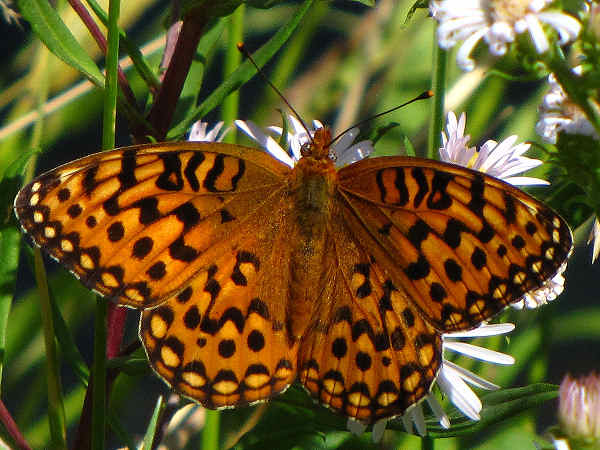Sara WrightI love butterflies and have always grown perennials that are good pollinators because they attract bees and butterflies as well as providing nectar for my hummingbirds. I also have milkweed plants growing in every open area on my property, and up until recently, used to raise a monarch or two from caterpillar to chrysalis to adulthood. Now that these butterflies are scarce I no longer do. This year I note that I am seeing fewer butterflies in general, much to my dismay. With one exception. All summer long I have been entranced by the number of Fritillaries that have been fluttering through my garden since late May. Such abundance, when so many butterflies are disappearing! The days of taking any wild creature for granted are over for me, and that includes the insects I see. After identifying the Fritillary that visits my garden as the Great Spangled Frittilary I began noticing others; some visit Peter’s Meadow across the street, a meeting place for many happy insects. Over the course of the summer I have also seen the Meadow, Aphrodite, and Atlantic varieties. The Great Spangled fritillary is my favorite, but I am a walking welcome mat for all that choose to visit!
Fritillaries are a large group in the butterfly family with many species that inhabit this country. All have tiny front legs that lack claws, thus the phrase used to describe them is ‘brush-footed’ butterflies. Fritillaries are medium – to large in size (wingspan can be as much 3 and ¾ inches) and their wings are bright orange or somewhat rust colored (depending upon the species) all with spots and wavy black lines. Since most fritillaries look somewhat similar it is necessary to examine wing patterns closely, something I never did until this summer. For example, fritillaries look a lot like Checkerspot and Crecent butterflies so its important to check some resources to be sure what you are seeing. There are excellent photos online that are well worth looking at. So much variation and such astonishing hues and patterns! Fritillary caterpillars vary in color depending upon the species, but most feature 6 rows of branching spines that go all the way down their two inch bodies. They are somewhat unfriendly looking to me! Their life cycle is similar to most butterfly species with egg, larval, pupal, and adult stages. The adults are active all summer long and although it is almost September I am still seeing some, though not in the numbers I had before. Presently they are feasting on my old fashioned hydrangea. Most species overwinter as larvae and emerge in early spring as caterpillars that only eat violets. No violets, no fritillaries. And some are endangered. Let’s hope that Maine.Gov removes violets from the invasive species list. The last thing we need is the loss of another butterfly. Fritillary adults and caterpillars are still ‘relatively’ common in mountain meadows, fields and other weedy areas. The Great Spangled fritillary, the one I see the most, has a Latin name that means Mountain or Earth Mother. They are the most frequently seen species inhabiting Northern and Eastern states. Let’s please do everything we can to keep them around! The adults mate in the summer; afterwards the females take a nap for a few weeks (diapause). In late summer they lay their eggs in patches of violets. Female Great Spangled fritillaries seem to be able to find the violets even after they have wilted. It is possible that they can smell their roots. Because the female does not lay eggs until fall the caterpillars emerge to feed when the violet plants are young and tender in early spring. Timing is important to the hungry caterpillar. It is feared that global warming may disrupt this synchronization; this would prove catastrophic to fritillary caterpillars. Studies are underway to verify whether this is already taking place. Because the caterpillars feed only on violets and I have carpets of them (which I refuse to have cut in either spring or fall) I wonder if this is why I have so many of these butterflies? The adult butterflies feed only on flower nectar. Around here they love butterfly weed, milkweed blossoms, white phlox (in particular) and bee balm best. Joe pye weed, black eyes susan, wild thistle (also on invasive plant list) and purple coneflower are other favorites. They do not hesitate to visit lilacs and butterfly bushes either. Because I spent four years in Northern New Mexico where I also kept a flower garden I knew I had seen the Great Spangled fritillary a few times. When I checked a number of sources I learned that this state has its share of fritillaries too – many more species than we have in Maine - and the Great Spangled fritillary was one, although it’s a bit smaller in size. Others included the Aphrodite, Edwards, and Southwestern fritillaries. What a diverse family of butterflies. I am thoroughly hooked! Most of these fritillaries live in wet mountain meadows where they can find violets on which to lay their eggs. But it is possible to see them just about anywhere. The adults are quite fond of blue flax, which I grew, and if I spend another winter there I would also grow violets in a pot in the hopes of attracting a visiting fritillary! In Santé Fe Great Spangled fritillaries feast on pansies, which of course, are members of the violet family. With so many insects disappearing at an alarming rate I am hoping that folks that read this article will consider buying pansies, and adding violets to their gardens or lawns ( refusing to cut the latter) so we give these beautiful butterflies a chance to stay around for awhile.
0 Comments
Your comment will be posted after it is approved.
Leave a Reply. |
Submit your ideas for local feature articles
Profiles Gardening Recipes Observations Birding Essays Hiking AuthorsYou! Archives
October 2025
Categories
All
|

 RSS Feed
RSS Feed